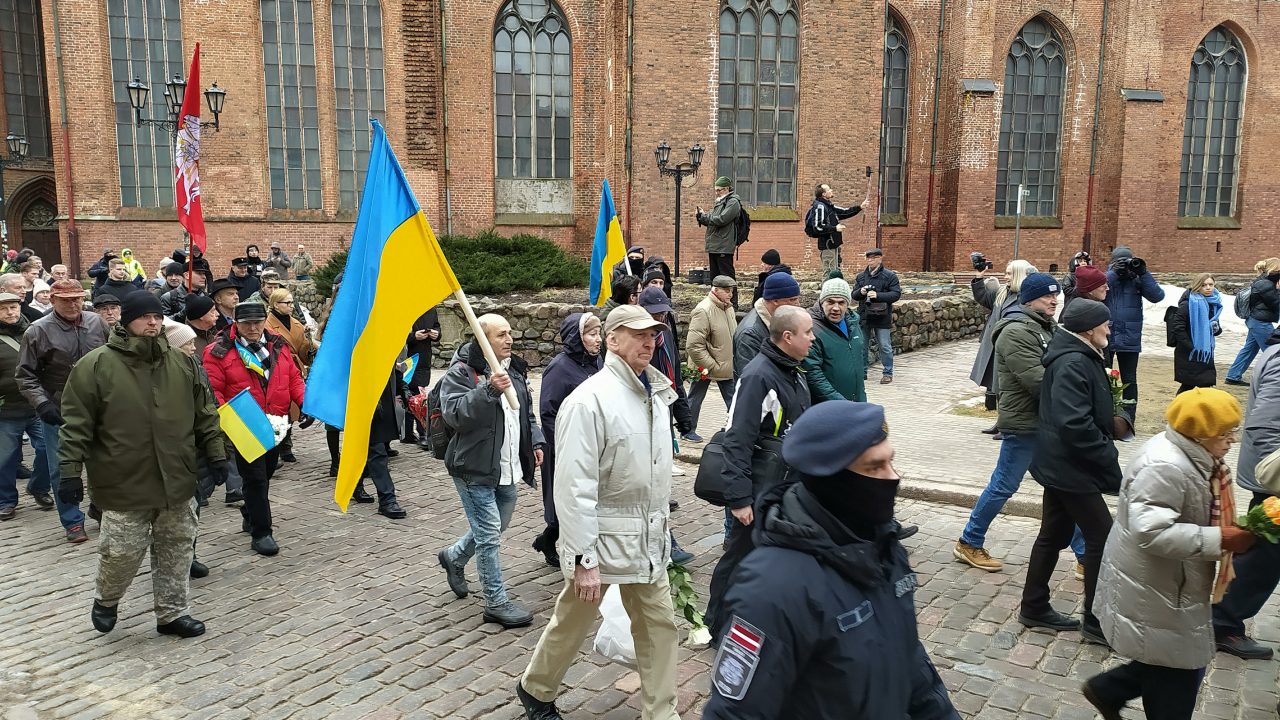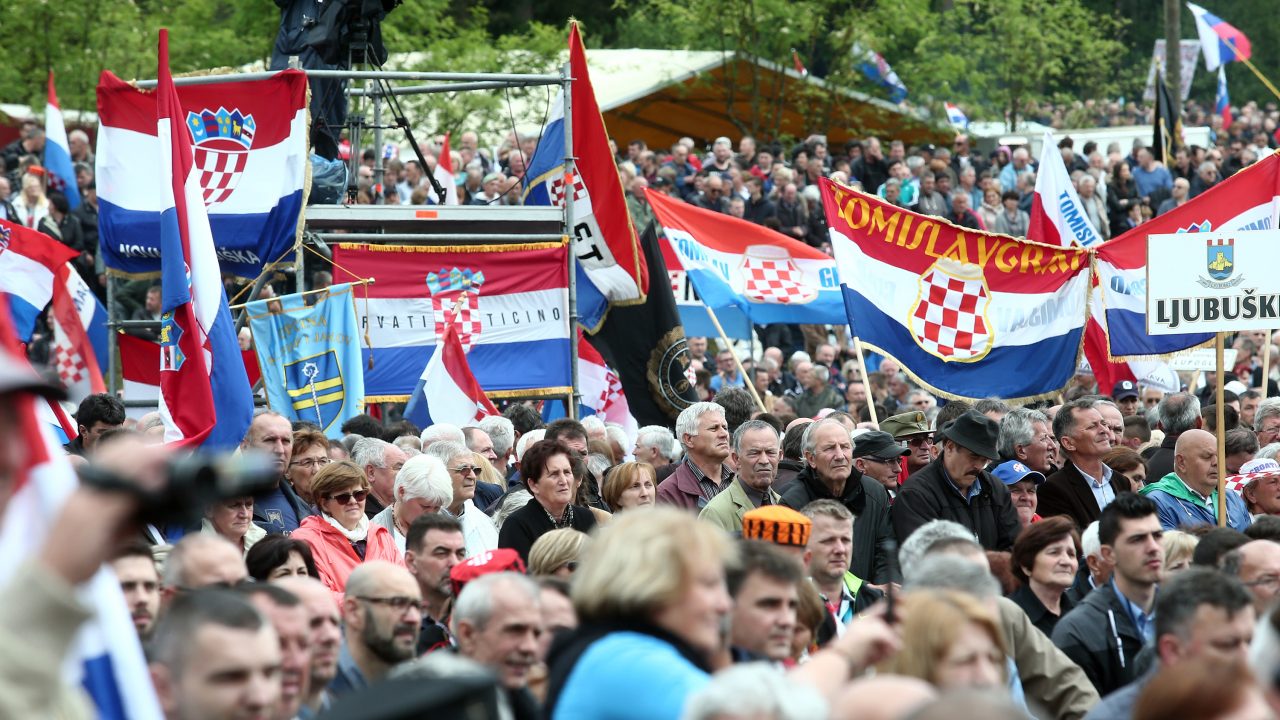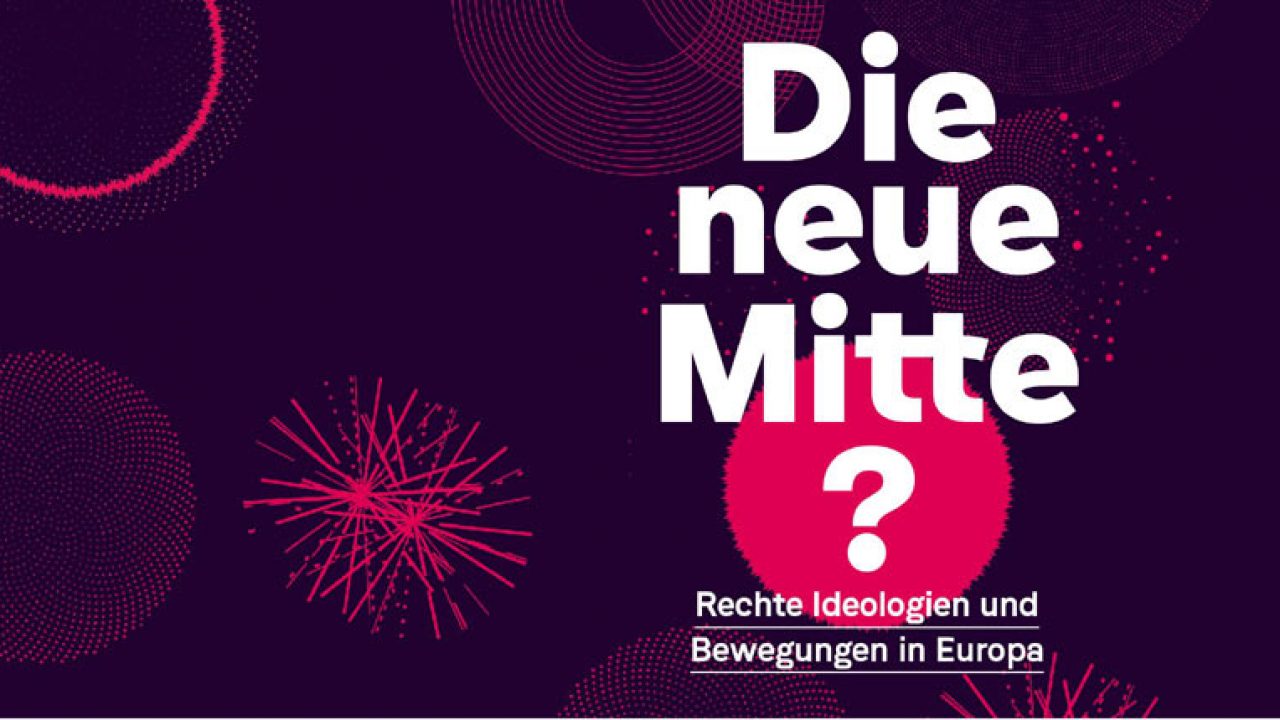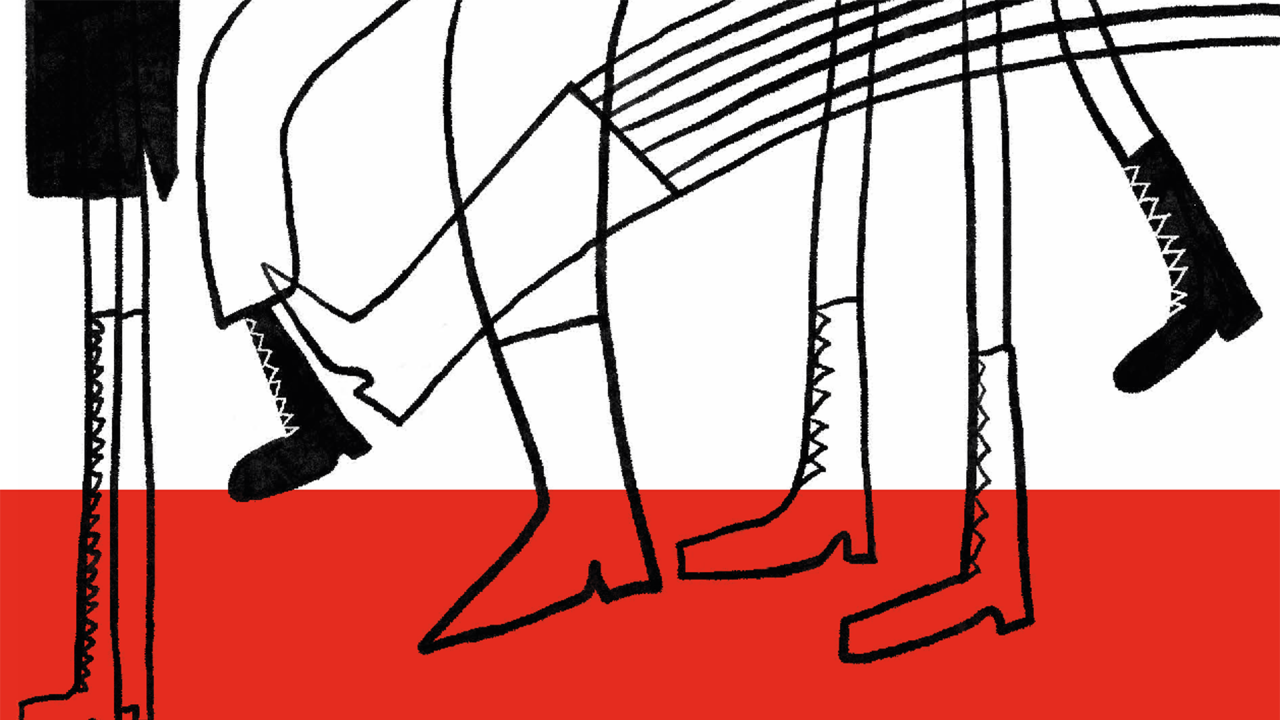
This text is an excerpt of the broschure „On Europe’s Streets – Annual Marches Glorifying Nazism“ by B’nai B’rith and Amadeu Antonio Foundation.
The marches promote antisemitism and Holocaust denial and distortion
As we have seen throughout our analysis of twelve far-right marches in Europe, antisemitism is not only a by-product, but a core element of the marches. Antisemitic incidents are commonplace, be it through the display of explicit banners and symbols, through slogans such as “Juden raus” and songs such as “AJAB”, through overt incitement by speakers, through shows of force in front of Jewish communal buildings or Holocaust memorial sites, and through veiled references wherever overt displays of antisemitism are criminalized and prosecuted.
Antisemitic conspiracy myths often play a prominent role in the marches. Common tropes include portraying Jews as “globalists” or “rootless cosmopolitans”, as the main antagonists in the form of “bankers” or “puppet-masters”, or the allegation that a “Zionist-Occupied Government” is the force behind a supposed “Great Replacement” of white Europeans with African or Muslim “invaders.”
Equally concerning is the recurring denial and distortion of the Holocaust. As described, the majority of the gatherings are explicit celebrations of Nazism and fascism, usually combined with attempts to rehabilitate Nazi war criminals and their collaborators.
Often the marches pay direct tribute to undeniably antisemitic historical figures, such as Benito Mussolini, Rudolf Hess, Ante Pavelić or Hristo Lukov, all of whom are either Nazis or Nazi collaborators, and of course Adolf Hitler himself. To allow them to be honored in public gatherings in the European Union is an affront to European values.
Veterans of Nazi combat units are honored and take active part in many of these marches in their old uniforms for as long as their health allows. According to an insidious narrative prominent in these circles, these veterans are heroes who were only or primarily trying to save Europe from communism, while the Shoah, the mass extermination of six million Jewish children, women and men is at best an unfortunate side issue, and at worst a disputed historical fact.
As we have seen in the examples of Dresden and Bleiburg, Holocaust distortion often takes the form of an inversion of roles between perpetrator and victim. These are two extreme examples of broader attempts by far-right movements to reshape the politics of memory in Europe.
Trivializing war crimes and genocide, rehabilitating war criminals, whitewashing the darkest chapters of European history, and eroding the boundaries of legitimate public discourse are the building blocks of a burgeoning far-right culture of remembrance that seeks to provide political legitimacy to ideas and actors that for good reason were excluded from democratic processes.
As is the case with overt displays of antisemitism, Holocaust denial and distortion will not always be explicit at the marches. This is certainly not for participants’ lack of endorsement of these ideas, but rather because they have acquired an understanding of the need to abide by the existing national legislation and preserve the public image of their movements.
Finally, another troubling fact is that whenever complaints concerning antisemitic incitement or Holocaust denial at the marches have been brought to the attention of the judicial authorities, as was the case after marches in Predappio in 2018, in Madrid in 2021, and in Dresden in 2022, these have been dismissed by prosecutors and judges, sometimes without due consideration. These decisions show that there is important work ahead raising awareness among the judiciary regarding the effective implementation of legislation on hate speech and memory laws.
The marches are networking opportunities for dangerous extremists
The individuals gathering multiple times a year at the marches represent far-right organizations and informal networks active throughout Europe. In many cases, they are affiliated with the so-called action-oriented sector of the neo-Nazi scene, i.e. belonging to informal, decentralized groups that tend to be less interested in political discourse than in acting out their ideology through violence.
To these groups, the marches are less about promoting ideology than they are about exchanging expertise, participating in combat training, and procuring weapons. Therefore, these marches contribute to creating and maintaining structures in place that at the very least increase the potential for violence at individual events, and at worst strengthen pan-European terrorist networks and allow violent criminals to go undetected.
These marches offer extremists the opportunity to increase their outreach and improve their skills under the guise of alleged commemorative or recreational activities. Most often, they attract exactly the kind of actors who pose a real threat to others. Among attendees, far-right Mixed Martial Arts (MMA) fighters join the marches, organize fighting events and provide intimidating security for the marches themselves. Occasionally, far-right football hooligans also play important roles.
Members of designated terrorist organizations, such as National Action or the Russian Imperial Movement, are often among the international attendees of these marches. They provide them with an opportunity to exchange information and share like-minded contacts across the continent.
Members of the far-right music scene also play a central role in the marches, especially through the Europe-wide Blood and Honour network and its right-wing terrorist arm Combat 18, but also through links with Hammerskins, Rechtsrock or Rock against Communism (RAC). This music culture often accompanies hate-based violence. In fact, the first international far-right events and networking opportunities were banned rock concerts that needed to relocate to other neighboring European countries.
Where for instance the Blood and Honour network is banned, such as in Germany, small far-right parties such as Der III. Weg or Die Rechte have surfaced as catch-all structures. Political parties are much more difficult to ban than wider neo-Nazi networks or so-called action-oriented comradeships. It is for this reason that neo-Nazis in Germany have opted for this form of organization, losing none of the determination and willingness to commit violent acts.
Among these groups, special emphasis is placed on cultivating a militaristic appearance and on assuming the role of ensuring “law and order.” This is, for instance, evidenced by the common tactic of not launching attacks directly during the marches, so as not to endanger their continuation. Attacks are often performed later, after the marches have ended, but are planned or prepared before or during the events.
Occasionally, however, as we saw in the cases of Warsaw and Athens, the marches derive a lot of their attractiveness from the fact that they unerringly end in violent excesses. The most vulnerable targets of these attacks are the groups that they perceive as undesirable: Jews, Roma, Muslims, migrants and refugees, LGBTQI+ people, but also counterdemonstrators and anyone standing in their way. It should be clear why these marches pose a threat to public security and public order.
Unquestionably, an end to marches glorifying Nazism and fascism will not end Europe’s neo-Nazi networks or far-right terrorism. Extremists are turning away from centralized movements and towards concepts of “leaderless resistance” and autonomous cells, promoted through materials shared widely online. The online space offers unlimited access to these materials and a broad range of networking opportunities, including through social media. Online communities offering anonymity have ushered in an era of online-radicalized and decentralized far-right terrorism, as we have seen on Utøya and in Oslo, in Halle, Hanau, or
Bratislava. These online communities only partially overlap with classical far-right terrorist structures, and no longer necessarily rely on them.
Nevertheless, physical gatherings still play a crucial role in strengthening far-right networks. Due to the criminal nature of many of its activities, the far-right scene is inherently paranoid. In-person meetings are much more conducive to building trust and establishing personal connections than online interactions.
Consequently, reducing the availability of offline meeting opportunities, and preventing neo-Nazis from paying homage openly and publicly to their inhuman ideology remains an important strategy in preventing the proliferation of pan-European far-right networks.
The marches foster a pan-European white supremacist ideology
Far-right extremists across Europe have come to realize that their beliefs resemble those of far-right extremists in other countries much more than those of democrats in their own countries. This has naturally resulted in the emergence of an internationalist movement of extreme nationalists. Various alliances can be forged under a pan-European far-right identity, and the marches described in this report are an important part of this process. Parts of the far-right have developed strategies towards establishing a common identity, often borrowing from white supremacist, or alt right ideology in the United States. The result is an ideology of a “white race” that needs to be defended through “white power.” This process was not without some incongruity. Since white supremacists in some European countries do not necessarily conform to each other’s ideas of “whiteness” or “Aryan-ness”, the concept of a “European race” or a “Christian culture” was put forward to describe the ethno-cultural community they claim to defend.
Attempts to establish a pan-European white supremacist identity go hand in hand with World War II and Holocaust revisionism, as they enable a common identity that can be conveyed, at least partially, to the majority of European societies.
Antisemitism also plays an important role in the forging of this identity and has surfaced as a prominent element of identitarian discourse. Particularly prominent is the antisemitic conspiracy myth that Jews have sown discord between the European peoples and that World War II was a “fratricidal war” between cultures that should belong together. Its conclusion is that these European peoples had to rally against the common enemy, imagined as a Jewish dominated “new world order.” This perverse narrative enables the construction of a pan-European white supremacist ideology, and is often on display at the marches, alongside other contemporary conspiracy myths targeting other vulnerable groups.
Approval by the general public is much less an objective of these marches, than the semblance of public approval for a resurgence of far-right revisionist ideology. When these marches are allowed to take place unhindered, the message is conveyed that this ideology should be regarded as acceptable in a democratic society.
In other words, where neo-Nazis are able to take to the streets in numbers, they are able to feel like the spokespersons of an imagined political plurality. The more these marches continue to proceed undisturbed, the more they will continue to create a shared experience on the streets for extremists, which will foster cohesion, encourage them to take bolder action and eventually metastasize into a pan-European white supremacist movement.
The marches intimidate and socially isolate vulnerable target groups
States have a positive responsibility to ensure the security of their citizens. Every march glorifying Nazism or fascism allowed to take place on Europe’s streets contributes to the perception that state authorities do not take sides between aggressor and victim. This reinforces a common view among vulnerable groups that public authorities will not be on their side in the event of a hate crime.
Occasionally, public authorities will regard counterdemonstrators as troublemakers and provocateurs who complicate or escalate the situation. From this perspective, dangerous neo-Nazis are transformed into peaceful and orderly demonstrators.
When Jewish communities fear for their safety in the face of far-right marches, as was the case in Athens, they are often portrayed as oversensitive – even in light of evidence of prior antisemitic incidents.
These sorts of reactions, from the public or the authorities, promote a chilling effect for democratic civil society. They weigh particularly heavily when these marches are supported by members of a ruling party, as is the case in many of the examples presented.
Lessons from the civil society response
Finally, while the legal response will be addressed in Part II, it is also important to address the civil society response, which plays an important role in countering the normalization the far-right.
As members of democratic societies, we should do everything in our power to make it as difficult as possible for neo-Nazis and fascists to carry out their activities. This necessarily includes those activities that are carried out in the public sphere.
As we have seen throughout the report, social movements, organizations of Holocaust survivors, Jewish communities and organizations, neighborhood committees and individual activists have spearheaded the response against these marches and in certain cases achieved considerable success.
Counterdemonstrations and other counteractions offer many opportunities for democratic civil society to provide context, set the tone, and communicate that it is not socially acceptable for extremists to glorify Nazism and fascism on European streets, that their message of hatred must be opposed, and that they cannot be allowed to march undisturbed.
Local authorities also have an important role to play here, doing their part not to allow far-right marches to take place on their intended and traditional routes, and at least to try to confine them to the outskirts of cities. At least neo-Nazis will not have the pleasure to gather at city’s most beautiful historical scenery if they want to pay homage to National Socialism.
But local authorities can also be churches as well as large companies, organizations, or cultural institutions such as theatres and museums which speak up against far-right ideology. Creative or artistic counter-actions like banners on buildings or decorations on routes convey this message and offer many opportunities to position oneself with a lot of different possibilities of explanations and tone. This helps to include different democratic actors to achieve the common goal. But all messages show: “You neo-Nazis cannot march undisturbed and without comment through our streets. We oppose the hatred you spread.” When far-right terrorists come to town, synagogues or mosques can be protected symbolically with chains of humans and lights or practically with giving them private security services. The media can report analytically about the contempt for humanity and far-right ideology at the marches or about their dangerous participants – and also about violence that arises in the vicinity of the marches.
Counteractions can also be creative. In 2019, for instance, local residents in Ostritz, Germany bought up all the beer from local supermarkets so that participants to a large far-right rock concert were left high and dry and made to realize that they were not welcome. These are symbolic, peaceful actions, but they resonate powerfully as a clear statement against the enemies of democracy.
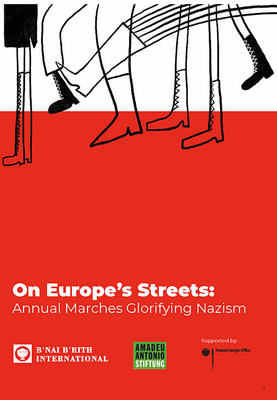
The report is available to download (in English):
https://www.amadeu-antonio-stiftung.de/publikationen/on-europes-streets/
Excerpts from the report on Belltower.News will follow!
Part 1: The Marches
1. Day of Honor, Hungary
2. Memorial March for the Bombing of Dresden, Germany
3. Lukov March, Bulgaria
4. Blue Division March, Spain
5. Remembrance Day of the Latvian Legionnaires
6. Bleiburg Meeting, Austria
7. Rudolf Hess Memorial March, Germany
8. Iron Wake, Belgium
9. March on Rome, Italy
10. Independence March, Poland
11. Kohti vapautta and 612-march, Finland
12. Imia March, Greece
Conclusion to Part I: The danger of the marches (also in German)
Part 2- Legal Analysis
